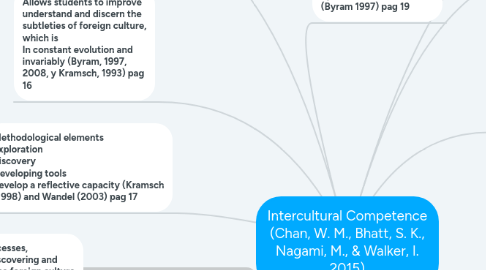Intercultural Competence (Chan, W. M., Bhatt, S. K., Nagami, M., & Walker, I. 2015)
by zuleyka andrea avila hernandez

1. Helps develop the sociolinguistic competence and equips students with the skills and knowledge necessary to communicate appropriately in a wide range of situations ((TDC, 2006, p. 18)
1.1. Parts of overall sociocultural competence: Cooperation -Respect-Tolerance of ambiguity-Reflection_Intercultural empathy-Acceptance of complexity ((Oxford, 2017b)
1.2. Sociolinguistic competence is necessary for the interpretation of grammatical utterances and the selection of appropriate linguistic structures to achieve one’s communicative (Hymes 1964, 1971, 1972)
1.3. Sociolinguistic competence, which describes one's ability to use the characteristics of a language appropriately (Swain 1980, and Canale 1982)
1.4. Specifies six sub-competencies: linguistic, sociolinguistic, discourse, strategic, sociocultural and social competence. (van Ek, 1986)
2. Establish and maintain interaction relationships reflects the complex and dynamic nature of culture and prepares students for effective and culturally sensitive communication with the target language and other new cultures, acting as intercultural Speakers and mediators. (Byram 1997) pag 19
3. Skills and processes, as those of discovering and interpreting the foreign culture ( Byram (1997) ) pag15
4. Set of Processes and complex and dynamic practices that emerge from socioculturality. (Crozet and Liddicoat (1997) pag 15
5. Allows students to improve understand and discern the subtleties of foreign culture, which is In constant evolution and invariably (Byram, 1997, 2008, y Kramsch, 1993) pag 16
6. Methodological elements exploration discovery Developing tools develop a reflective capacity (Kramsch (1998) and Wandel (2003) pag 17
7. Intercultural competence ability that a person possesses to act adequately and flexibly in front of people of other cultures. (Byram’s model of intercultural communicative competence and the sub-components of intercultural competence (source: Byram, 1997, p. 73; N.B.: “t” – teaching, “l” – learning)
8. Savoir être, Savoirs, Savoir comprendre, Savoir apprendre/faire, Savoir s’engager.
9. Rejection of difference Enjoyment of difference Embracing of difference Transcendence of difference
10. Three main variables: context; the inner state of the individual at a given time, or generally; and the particular personal dynamics between interactions when the encounter with difference happens through a verbal communicative act.
11. Through the intercultural approach, foreign language education has gained relevance in communicative competence ((Byram, 2008)) pag 17
12. Linguistic competence, to describe the knowledge and skills required for interaction and the appropriate use of language in a social context, including an understanding of the system of grammar use. (Hymes, 1974)pag 10
12.1. Linguistic competence to be the basic component of communicative ability, (van Ek)1986)
13. Intercultural understanding is defined as people’s ability to understand, appreciate, and be open to various aspects and forms of cultural and social diversity. (Kramsch 1993)
13.1. Make and highlight connections between language use and cultural values. Respect differences between languages and cultures. Respect differences that students from various native languages experience. Use problem-based learning and/or scenario-based learning to understand people from another culture. Help students become aware of negative situations
14. Ethnocultural empathy refers to the ability to understand the feelings of individuals who are ethnically and/or culturally different from oneself. (Kramsch 1993)
14.1. it involves an emotional response that is congruent with the perceived


